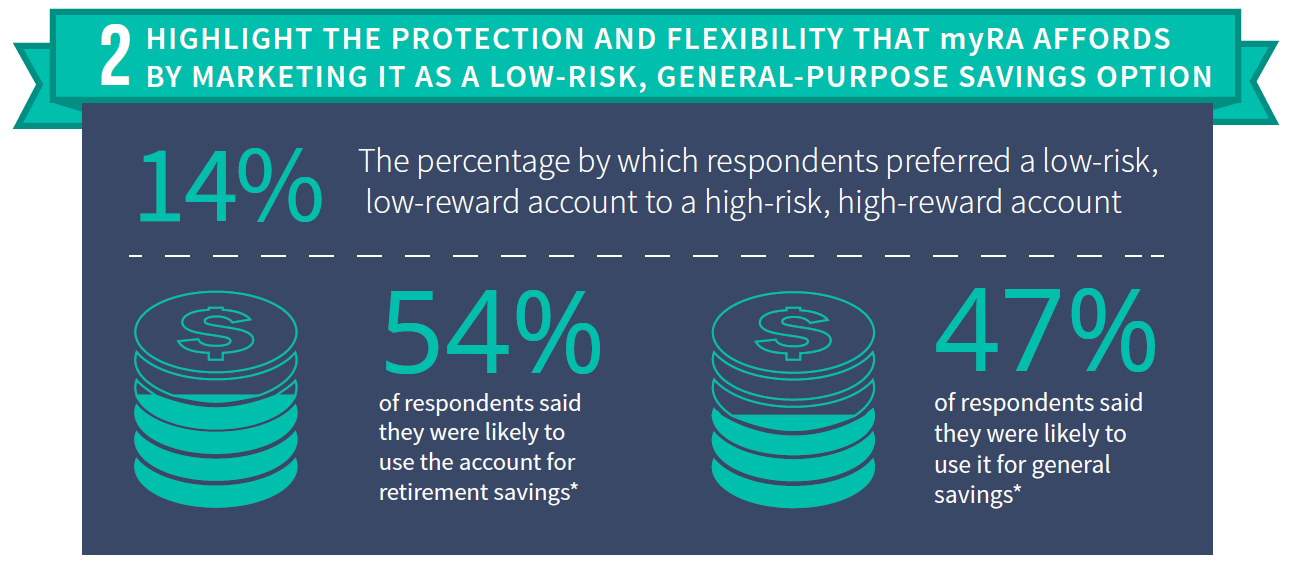myRA and Secure Choice
Building Savings Accounts That Consumers Want
Blog Post

March 16, 2015
In the last year new, innovative retirement savings products have been designed and implemented at the federal and state levels. The U.S. Treasury launched and is piloting myRA, an account where workers who lack access to an employer-sponsored retirement account can save in Treasury securities. State governments, led by Illinois, are working to ensure universal, automatic enrollment in retirement accounts for residents. These bold initiatives have been crafted in response to decades-worth of unsettling data showing that Americans are not saving enough money. For example:
- 36% of American adults have not started saving for retirement
- One quarter of Americans have no emergency savings
- Half of American workers do not have access to an employer-sponsored retirement plan
Because these new retirement savings products are designed for first-time and small-dollar savers, they prioritize flexibility and accessibility. For example, myRA is portable, allowing workers who switch jobs to take the account with them. It does not have fees or require a minimum contribution, unlike many privately-administered retirement savings plans. The Illinois program, Secure Choice, requires automatic enrollment that will help remove hurdles to participation.
D2D recently published findings from our original consumer research about financially vulnerable consumers’ preferences for how accounts like myRA are designed, marketed, and distributed. Our findings have implications not only for existing retirement savings products, but also those that will be designed in the near future by states following the lead of Illinois and the U.S. Treasury.

Consumers are interested in flexible, multi-purpose accounts where they can save for short- and long-term needs. Among consumers D2D surveyed, 64% wanted to use a product like myRA. They were equally interested in using the account to save for retirement and general savings needs. These findings reflect the reality that many consumers are already drawing down their retirement savings to pay for everyday expenses. The typical American household in the bottom quintile of income can cover only nine days of expenses with liquid savings; the typical middle quintile household can cover just 21. Those low amounts of savings help explain why 35% of workers with retirement accounts who make less than $50,000 per year have taken an early distribution from those accounts.
MyRA and Secure Choice are already designed as Roth IRAs to better meet consumers’ desire and need for flexible savings products, but those consumers who are new to saving may not understand that. To realize even more impact, the accounts need to be marketed as:
- Multipurpose products that are suitable for retirement and general savings, such as emergencies, education, and home purchases.
- Low-risk savings vehicles that offer principal protection and government backing.
A retirement account like myRA can encourage Americans to be aspirational long-term savers while still giving them the flexibility to use their savings for short-term needs. It offers a simple, streamlined option for consumers who may not want to manage more than one savings account.

D2D has also identified additional design considerations for future products that could help make them even more accessible. Retirement savings accounts for financially vulnerable consumers should:
- Allow enrollment through a variety of channels, including banks, employers, and directly through a government portal;
- Allow account opening and funding at tax time in a process similar to how consumers can now save in U.S. Savings bonds via federal tax forms. There are indications that the U.S. government is already working to implement that option for myRA, and state governments should follow suit for their respective plans; and
- Offer deposit options that are popular among financially vulnerable consumers, including cash and prepaid cards.

There are many more ways to amplify the effects of myRA and state-sponsored retirement products by leveraging insights from D2D’s innovations, including gamification and prize-linked savings. But, the first step is getting the product design, marketing, and distribution right, and D2D is energized by existing efforts to expand access to quality retirement savings products for all Americans.
For more information about D2D’s survey of consumer preferences for innovative retirement savings plans, you can view our infographic.
